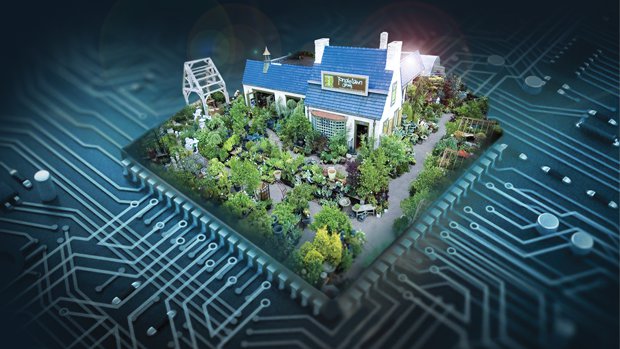3 Ways Technology Is About To Change Garden Retail
 For those who are not programmers, few things in life are more frustrating than technology. Say you update your store’s website daily, and you want to upload a simple voice recording. You’ve uploaded countless photos and videos in the past, so a voice clip shouldn’t be a problem.
For those who are not programmers, few things in life are more frustrating than technology. Say you update your store’s website daily, and you want to upload a simple voice recording. You’ve uploaded countless photos and videos in the past, so a voice clip shouldn’t be a problem.
It seems so simple. But as is often the case with technology, just because it looks simple, it doesn’t mean that the solution isn’t convoluted and pricey to create.
So it was no surprise when the 10% Project Advisory Committee identified a lack of technological sophistication as something that stands in the way of retailers being able to get more sales from plants, as well as the rest of the store.
Consider this a report of an ongoing dialogue that is taking place in our industry. Here are three areas that are on top of garden retailers’ wish lists, areas that promise lasting change.
1. Integrated POS Systems
Garden retailers watch the ease consumers have with researching products online with large retailers like Best Buy and Kohls. Not only is all the product information available, but making a purchase is easy, too.
One retailer said he’d like to have the ability to do whatever customers wanted with his plants. Say he has a red-tipped Photinia on the sales floor. He’d like to be able to have Photinia care tips, data and background online, as well as the ability to post that plant on Amazon, eBay and any other sales format he wants.
Those plant retailers who have ventured into eCommerce have come up against many barriers and frustrations: Targeting the right audience, making sure your plants arrive in good condition and you stay compliant with state regulations when shipping over state lines (California, in particular), etc.
But the largest block to being able to offer these customer-expanding services is the lack of an affordable inventory control system that is able to track product accurately, no matter which platform customers use to buy from you.
Most garden retailers aren’t interested in nationwide-type eCommerce. But as far as the inventory system is concerned, the costs are similar.
The culprit for much of the higher costs comes from the software associated with PIM data, says Epicor’s Sam Kirkland. PIM, which stands for personal information management, is what makes interfacing with sites like Amazon so easy. It is what brings each plant and bag of mulch in your POS to life, with basics like photos, plant information, marketing materials and so on. PIM data could allow a retailer to integrate his online presence and his marketing message with what is actually in inventory whenever he wants.
Local restaurants, however, have found an effective way to get in on the eCommerce game. If they do not belong to an online ordering and delivery company like GrubHub, they can simply post their daily menu online, with offers for pick-up and delivery.
Even as PIM data software begins to trickle down to where local businesses can afford it, retailers have come to realize that online systems require skilled staff just as much as the plants on the sales floor do to ensure the customer gets what she needs.
Kirkland urges store owners to think of eCommerce as a second location.
“The costs will be similar. You’ll need to have some funding behind it to do it,” he says.
Another area that will need to be ironed out is making sure every product that can be sold has its own barcode (or perhaps radio frequency, once that becomes standard). More and more garden retailers are bar coding even 4-inch annuals by variety and color, a practice that was a true anomaly just two years ago.
“Bar coding everything makes it easier to promote via social media,” says Richard Christakes, co-owner of Alsip’s Home & Garden in the Chicago area.
If every plant is itemized in an integrated POS system, the marketing and selling opportunities abound.
2. Secure In-Store Wi-Fi Key To Mobile Sales
Mobile checkouts have received a lot of attention and frustration. Most big sales take place out in the plant yard, far from registers or computers. It makes sense to use mobile devices to serve customers.
However, those devices need to be integrated into inventory systems and secured. And that can be pricey.
“We’re having a hard time weighing the costs against the pros and cons,” says Rachel Banko with Grossman’s Garden & Home in Penfield, N.Y.
Kirkland agrees retailers should weigh the costs/benefit ratio of mobile devices.
“I would look at my most active time for people trying to check out. How many devices would make an impact? If I can get X more people through, is that worth $1,000?” he says.
On top of that consideration, customer service needs to be factored in, as well, he says.
“Next year, we are aiming for mobile units which will already have customer info on an iPad. Our customers are telling us the process now isn’t working, and they would spend more if we changed the system,” says Gina Schaefer, who owns nine Ace Hardware franchises in the Washington, D.C., and Baltimore area.
But up-front costs are not the only risks of handhelds.
Other issues retailers worry about are how well the devices will survive in a garden center setting (all that water), if employees can be trusted with them and if any sales completed on mobile devices makes them vulnerable to breaking new PCI compliance rules.
Tablets are vulnerable to theft, and they are too big to keep in a holster the way walkie-talkies or phones are. The likelihood of an employee leaving them behind on a plant bench, which can then be watered, is high.
“If you have five tablets, will you damage one a year? Probably. Garden centers have to be one of the worst climates against devices,” says Kirkland.
But even though you will replace mobile devices more frequently than your traditional checkout systems, most experts predict mobile checkout will be the standard.
And garden retail lends itself to mobile services even more than other industries.
“If you are able to not only check customers out but help them understand what they’re buying, then you’re getting somewhere,” says Kirkland. “You can say, ‘This is what this plant looks like when it’s bigger’ and conduct diagnostics. If I could walk with someone through my business and use the same device from department to department, and I can check them out on that spot, that’s powerful. It’s beyond just Point of Sale.”
The key to making all this work is a very secure, encrypted Wi-Fi connection, Kirkland says. You have to protect yourself and your customers from being hacked within your store. If you have that in place, you can use off-the-shelf tablets, so long as both the software and the Wi-Fi network are secured.
“Make sure business is secure and that you conform to PCI standards. I’m comfortable with this happening in a business today. Most POS systems have a mobile POS option,” he says.
One issue that needs to be addressed if retailers go down this road is how to handle cash transactions.
“You can have a money belt, but that creates security issues for your staff. I can see a house charge account or a credit card transaction working for this kind of set up, so long as the credit card device is EMV capable,” Kirkland says.
3. Online Ordering Is Taking The Place Of Vendor Reps
It’s no secret that many suppliers, from growers to hard good manufacturers, have decided to see how few sales representatives they can get by on. It’s a move that’s not popular with most retailers. They do not get as much information as they used to about new products and which plants are prime material. That especially is a problem for more remote stores. The reps left are covering much larger territories, which means remote stores often are cut from the travel itinerary.
Suppliers are offering online ordering as a replacement, which retailers say is a poor substitute.
For one, suppliers all have their own systems, forcing retailers to adapt. Some small growers still rely on fax, while others want retailers to log into a system that has been inched along since the 90s.
But that is changing rapidly. And a crowd of upset customers is making sure a solution that works for everyone is put in place.
“It would be nice to have some interaction with our POS system. Have them help us coordinate somehow,” says Ken Lain, who owns Watters Garden Center in Prescott, Ariz.
The key for that is having the suppliers’ and retailers’ POS systems work together. And some suppliers are ahead of the game.
David Kirby, vice president of sales at Monrovia, says Monrovia is trying to figure out a way to meet that need.
“Something we’re doing is we have a dashboard we share with our bigger retailers. It tells you what our sales to them look like, and it looks at your POS and your sell-through data. It takes all that information and lets you know what the most important plants are so you can create more value and profit with them.”
This year was a trial year, and Kirby expects to see the program improved and streamlined. It will open up to more customers in the future.
Several other suppliers are trialing solutions, although most are less sophisticated than Monrovia’s. Distributors like BFG have offered programs that have an automatic reorder once levels reach a certain level, for example. Just imagine where this type of POS to supplier system will lead us.
We asked some suppliers how they see technology changing how they interact with their customers. Here are three answers we received:
There are tools out there now such as Google+ and Skype that could be leveraged to assist in getting face-to-face with both parties. Mobile technology in general has made communication so much faster as well. When I was a territory sales representative just a few years ago, it surprised me when I started getting orders and communications from customers via text – which today is now commonplace. Because we are more connected, the need for that on site visit MAY be minimized to a point. When face-to-face, the collaboration is much higher and the visit typically ends up being more productive, simply because it allows for more of a consultation opportunity than electronic means can provide
Alec Charais, Bailey NurseriesWe have certainly heard from our customers about the need for increased online information. We regard our sales reps as our biggest asset and as brand ambassadors for Monrovia we have an expectation that they are in front of their customers more than any other competition. Having said that, we have also created a customer portal for our customers which allows them to view their pre booked orders as well as a current availability. In 2013 we began the process of taking photos of each of our shippable plants in order to manage the expectation of the rep and customer. This PAL (photo availability list) program is also available to our customers online and our reps use the tool to create weekly hot lists for heir territory.
David Kirby, MonroviaAs our sales grow and customer counts go up, we see more and more interest in systems like Ball Seed’s WebTrack that lets growers access live inventory and order 24/7. It’s driven more by the need for convenience and control versus fewer reps or rep visits. We have more on the road reps than ever in our history. And more online ordering every year. The rep is a trusted resource. WebTrack is the business management system that saves growers time and puts info at their fingertips any time of the day.
Bill Calkins, Ball Horticulture
Smart Technology Choices Will Help You Build A Future
All three technology advances written about here are ultimately about the customer, even being able to better communicate with vendors. Technology can give retailers a way to connect with a new generation of buyers.
“We face a potential lack of relevance of gardening for the next generation of consumers,” says Ball Horticulture’s Bill Calkins. “We have the right products, but we’re not aiming well enough.”
Ultimately, technology gives retailers the tools they need to help customers better understand the plants in their lives and to interact with you both in person and virtually.











